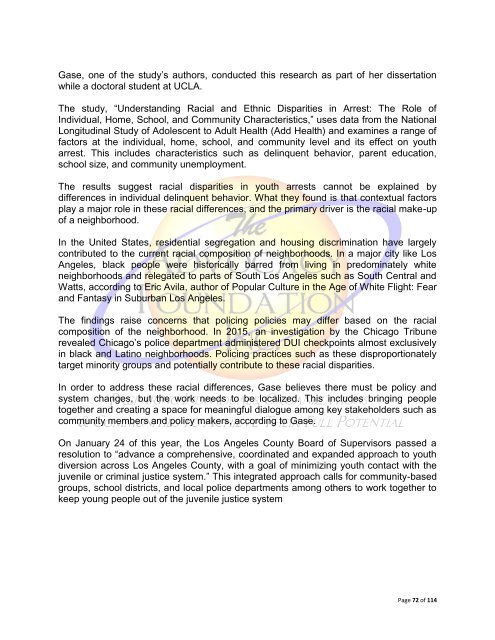African-American Youth in The Juvenile Justice System
African-American Youth in The Juvenile Justice System
African-American Youth in The Juvenile Justice System
Create successful ePaper yourself
Turn your PDF publications into a flip-book with our unique Google optimized e-Paper software.
Gase, one of the study’s authors, conducted this research as part of her dissertation<br />
while a doctoral student at UCLA.<br />
<strong>The</strong> study, “Understand<strong>in</strong>g Racial and Ethnic Disparities <strong>in</strong> Arrest: <strong>The</strong> Role of<br />
Individual, Home, School, and Community Characteristics,” uses data from the National<br />
Longitud<strong>in</strong>al Study of Adolescent to Adult Health (Add Health) and exam<strong>in</strong>es a range of<br />
factors at the <strong>in</strong>dividual, home, school, and community level and its effect on youth<br />
arrest. This <strong>in</strong>cludes characteristics such as del<strong>in</strong>quent behavior, parent education,<br />
school size, and community unemployment.<br />
<strong>The</strong> results suggest racial disparities <strong>in</strong> youth arrests cannot be expla<strong>in</strong>ed by<br />
differences <strong>in</strong> <strong>in</strong>dividual del<strong>in</strong>quent behavior. What they found is that contextual factors<br />
play a major role <strong>in</strong> these racial differences, and the primary driver is the racial make-up<br />
of a neighborhood.<br />
In the United States, residential segregation and hous<strong>in</strong>g discrim<strong>in</strong>ation have largely<br />
contributed to the current racial composition of neighborhoods. In a major city like Los<br />
Angeles, black people were historically barred from liv<strong>in</strong>g <strong>in</strong> predom<strong>in</strong>ately white<br />
neighborhoods and relegated to parts of South Los Angeles such as South Central and<br />
Watts, accord<strong>in</strong>g to Eric Avila, author of Popular Culture <strong>in</strong> the Age of White Flight: Fear<br />
and Fantasy <strong>in</strong> Suburban Los Angeles.<br />
<strong>The</strong> f<strong>in</strong>d<strong>in</strong>gs raise concerns that polic<strong>in</strong>g policies may differ based on the racial<br />
composition of the neighborhood. In 2015, an <strong>in</strong>vestigation by the Chicago Tribune<br />
revealed Chicago’s police department adm<strong>in</strong>istered DUI checkpo<strong>in</strong>ts almost exclusively<br />
<strong>in</strong> black and Lat<strong>in</strong>o neighborhoods. Polic<strong>in</strong>g practices such as these disproportionately<br />
target m<strong>in</strong>ority groups and potentially contribute to these racial disparities.<br />
In order to address these racial differences, Gase believes there must be policy and<br />
system changes, but the work needs to be localized. This <strong>in</strong>cludes br<strong>in</strong>g<strong>in</strong>g people<br />
together and creat<strong>in</strong>g a space for mean<strong>in</strong>gful dialogue among key stakeholders such as<br />
community members and policy makers, accord<strong>in</strong>g to Gase.<br />
On January 24 of this year, the Los Angeles County Board of Supervisors passed a<br />
resolution to “advance a comprehensive, coord<strong>in</strong>ated and expanded approach to youth<br />
diversion across Los Angeles County, with a goal of m<strong>in</strong>imiz<strong>in</strong>g youth contact with the<br />
juvenile or crim<strong>in</strong>al justice system.” This <strong>in</strong>tegrated approach calls for community-based<br />
groups, school districts, and local police departments among others to work together to<br />
keep young people out of the juvenile justice system<br />
Page 72 of 114

















